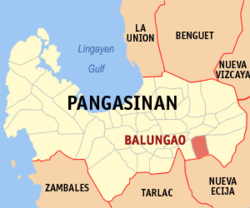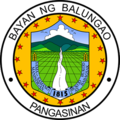Balungao | |
|---|---|
| Municipality of Balungao | |
 Balungao Town Hall | |
 Map of Pangasinan with Balungao highlighted | |
 Interactive map of Balungao | |
Location within the Philippines | |
| Coordinates: 15°54′N120°42′E / 15.9°N 120.7°E | |
| Country | Philippines |
| Region | Ilocos Region |
| Province | Pangasinan |
| District | 6th district |
| Founded | March 19, 1815 [1] |
| Named after | Mount Balungao |
| Barangays | 21 (see Barangays) |
| Government | |
| • Type | Sangguniang Bayan |
| • Mayor | Maria Theresa R. Peralta |
| • Vice Mayor | Philipp D. Peralta |
| • Representative | Marlyn Premicias Agabas |
| • Municipal Council | Members |
| • Electorate | 21,533 voters (2025) |
| Area | |
• Total | 73.25 km2 (28.28 sq mi) |
| Elevation | 50 m (160 ft) |
| Highest elevation | 382 m (1,253 ft) |
| Lowest elevation | 29 m (95 ft) |
| Population (2024 census) [4] | |
• Total | 30,678 |
| • Density | 418.8/km2 (1,085/sq mi) |
| • Households | 7,908 |
| Economy | |
| • Income class | 4th municipal income class |
| • Poverty incidence | 15.67 |
| • Revenue | ₱ 265.7 million (2022) |
| • Assets | ₱ 704.4 million (2022) |
| • Expenditure | ₱ 148.2 million (2022) |
| • Liabilities | ₱ 38.95 million (2022) |
| Service provider | |
| • Electricity | Pangasinan 3 Electric Cooperative (PANELCO 3) |
| Time zone | UTC+8 (PST) |
| ZIP code | 2442 |
| PSGC | |
| IDD : area code | +63 (0)75 |
| Native languages | Pangasinan Ilocano Tagalog |
Balungao, officially the Municipality of Balungao (Pangasinan : Baley na Balungao; Ilocano : Ili ti Balungao; Tagalog : Bayan ng Balungao), is a municipality in the province of Pangasinan, Philippines. According to the 2024 census, it has a population of 30,678 people. [6]



